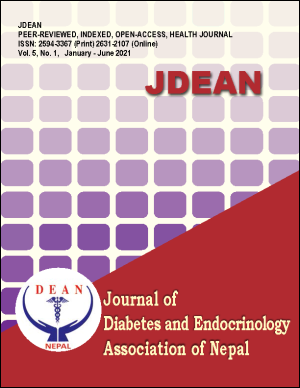Utility of hsCRP as an add onn to Lipid Profile for Cardiovascular Risk Stratification in Adults with Type 2 Diabetes Mellitus
DOI:
https://doi.org/10.3126/jdean.v5i1.38800Keywords:
Dslipidemia, hsCRP, Lipid ProfileAbstract
Introduction: Dyslipidemia is common in Diabetes and is predictive of cardiovascular events. But, myocardial infarction in the setting of normal lipids levels is not uncommon. hsCRP has been studied elaborately and is found to be a stronger predictor of heart attack and stroke than LDL cholesterol. We conducted this study to observe the level of hsCRP in adults with Type 2 Diabetes and its association with lipid parameters.
Methods: It is a cross sectional study including 168 Type 2 Diabetes patients conducted in department of biochemistry and internal medicine at B.P. Koirala Institute of Health Sciences, Dharan, Nepal for duration of one year. The ethical clearance was taken from the institutional ethical review board and patients were enrolled after taking informed consent. Venous blood was collected and serum lipid profile and hsCRP were measured.
Results: The means±SD for age, TC, HDL-C, LDL-C and HDL/LDL ratio of patients were 52.2±11.9 years, 182.9±41.9 mg/dl, 41.6±8 mg/dl, 94.9±20 mg/dl, and 0.47±0.18 respectively. The medians of TG and hsCRP were 152.5 (109, 195) mg/dl and 1.9 (0.9, 2.8) mg/dl respectively. hs-CRP was found to have significant positive correlation with TC (r=0.286), LDL (r=0.652) and TG (r=0.299) and significant negative correlation with HDL (r= -0.614) and HDL/LDL ratio (r= -0.646). Only 33% of patients were categorised as having increased CVS risk according to high LDL levels but altogether 75% of patients had increased CVS risk according to hsCRP levels.
Conclusion: hsCRP can be considered as an add on to lipid profile while predicting CVS complications in patients with Type 2 Diabetes Mellitus in our population.
Downloads
Downloads
Published
How to Cite
Issue
Section
License
Copyright (c) 2021 J.K. Baranwal, R. Maskey, S. Majhi, M. Lamsal, N. Baral

This work is licensed under a Creative Commons Attribution-NonCommercial 4.0 International License.
This license enables reusers to distribute, remix, adapt, and build upon the material in any medium or format for non-commercial purposes only, and only so long as attribution is given to the creator.




